|
The Nivada Chronomaster chronograph

Although less known than its famous contemporaries that are the Heuer Carrera, Breitling Top Time or the Omega Speedmaster, the Nivada Chronomaster chronograph represents the quintessence of the Swiss chronograph of the 60's : a single name, a design easy to recognize, and a variation in multiple dials and movements. Usual today, this proliferation of models was new at the time and it supported the revival of the chronograph which was then in loss speed. But what was the historical context and to what the various versions of the Chronomaster resemble?
One knows in fact few things about Nivada. According to Pritchard the company would have been created in 1926 in Granges (Grenchen) by Jacob Schneider then took over by his son Max who was always at the head of the company in 1976. In the United States Nivada was distributed by the Croton Company. One can find watches signed Nivada, Croton or carrying the double signature Croton and Nivada Grenchen. The addition of the name Grenchen to Nivada seems to come from a dispute with Movado in the United States which found “Nivada” too close to “Movado”.
In the years 1930 Nivada was one of the first companies to manufacture automatic watches. Other watches found in the catalog were small ladies watches, watches with double dial and watches made in “rustless steel” evidence that the company was interested by the innovations of the time.
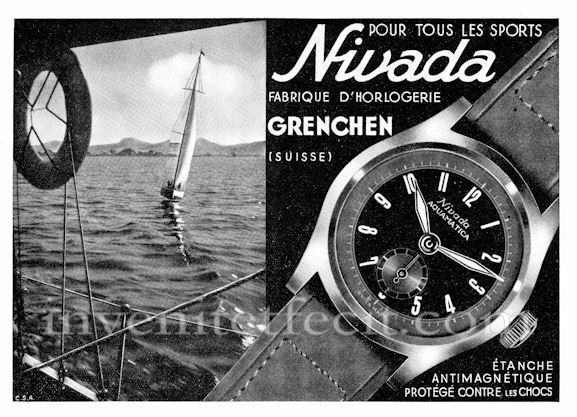
Ad. from 1940
A turning seems to have occurred in the Fifties. Within the framework of the International Geophysical Year, Nivada created a waterproof automatic watch called Antartic which was worn by the members of the Deep Freeze 1 expedition of the American Navy in 1955-1956 during an international exploration campaign of the South Pole. It was at the time the last continent still to be discovered. The repercussion will be very important for Nivada which will produce Antartic models during many years.
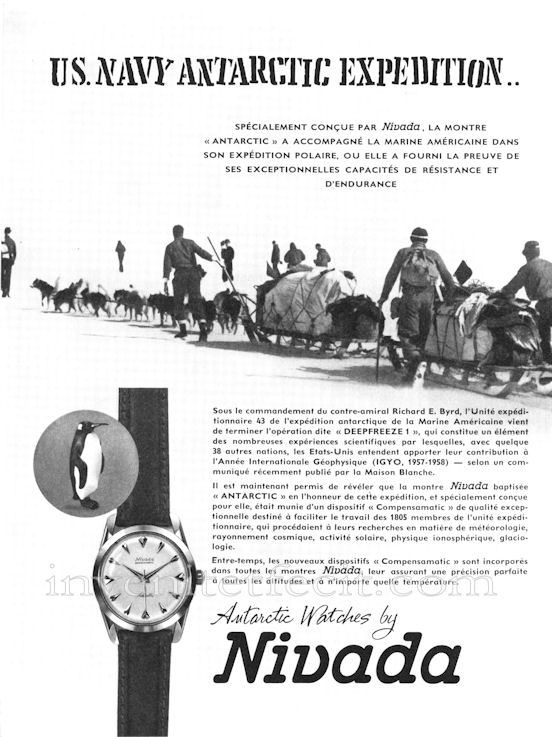
Nivada Antartic. Ad. from 1958
The image of a watch able to resist the extreme conditions will be reinforced in the Sixties with the launching in 1964 of the diver's watch Depthomatic, first watch with an indicator of depth, or bathymeter, and the following year by the launching of the Depthmaster watch, able to withstand a pressure of 100 atmospheres, which corresponds to 1,000 meters.
The Chronomaster chronograph is launched in 1963. It is presented like a diver's chronograph, waterproof to 200 m. It carries in fact 3 inscriptions: Chronomaster, Aviator, Sea Diver. Ground, air, sea in a certain way, a beautiful program! The time was indeed with great explorations and with sporting big firsts, and the Swiss companies do not miss the occasion to join it to make known itself. Of return of the top of the Everest in 1953 Edmund Hillary praises the virtues of its Rolex, Vulcain climbs on the K2, Enicar on the Lohtsé and Tissot in 1956 on the Aconcagua, highest summit of the Andes cordillera. On the sea side, in 1960 Rolex clings to the sides of Piccard's Trieste which goes down to 11,000 meters, Zodiac, Vulcain, Enicar, Blancpain accompany famous divers such as Cousteau, Hass and Keller. To the poles, Universal provides in 1958 the members of a franco-swiss expedition, Zenith stays in 1960 in the Kerguelen Islands, Enicar explores the archipelago of Spitzberg and Mido is chosen by the Australians at the time of the International Geophysical Year which will see the appearance of the model Nivada Antartic. In the airs, Rolex crosses the sound barrier with Chuck Jaeger in 1947, Universal passes above the pole with Scandinavian Airline in 1954, Breitling is at the wrist of Scott Carpenter for its flight in the space on May 24th 1962 and the Omega Speedmaster is selected in 1965 by the NASA to accompany the astronauts during the Gemini program.
All these exploits subject the watches to hard test and their resistance is also explained by many technical improvements made to the wrist watch in the field of the automatism, watertightness, quality of glasses and steels, etc. All of this will benefit of course the Chronomaster chronograph.
However, at the end of the years 1950, competed by the automatic watches and the waterproof watches, the chronograph does not make any more receipts. In 1960 the Swiss "Federation Horlogere" creates a working group “Chronographs and Stop-watches”, chaired by Willy Breitling, and launches in 1962 a vast promotion campaign of the chronograph in the majority of the European countries, relayed by the manufacturers who launched new models at this time. The result was with the height of the hopes: the Swiss export of chronographs in Europe passed from 52,000 units in 1964 to more than 173,000 in 1969.
It is at this time that the principal actors in the field of the chronograph inaugurate the marketing principles of the modern watch: a name, a strong design and a whole range of versions to allure a young public avid of innovations. Let us quote the Breitling Top Time launched in 1964 in 6 different versions, the Heuer Carrera presented in 1963 and its 4 versions, or the Omega Chronostop of 1967 and its dozen different versions.
First models: 1963-1970.

Prototype of Nivada Chronomaster with his bezel, its hands and its meters characteristic. This one is equipped with a Valjoux 92
The 1963 Nivada Chronomaster is typified enough: a black dial, a steel case, a graduated revolving bezel, round push-pieces, and a hand of the hours in the shape of arrow, true means of recognition. These arrow hands were not however new: one had seen them for the first time on a chronograph in 1958 and it was on the Omega Speedmaster, in its first version.
The revolving bezel appeared as early as of the years 1940 on chronographs made by Movado and Breitling. But in its version for diver's watch, with 60 minutes graduation, it is necessary to wait until 1958 with the Blancpain Air Command and 1959 with the Breitling Super Ocean. The Chronomaster approaches besides design of the Super Ocean: same black dial with only two sub-dials, same arrow hand for the hours and same push-pieces. In the same way, there are no numerals on the dial but hour-symbols.
The revolving bezel of the Chronomaster has a distinguishing mark: it comprises in fact two scales, one of 60 graduations for the minutes and one of 12 for the hours.
The dial is signed “Nivada Grenchen”. In the United States one can find “Croton” or “Croton Nivada Grenchen”.
The dial is black and the sub-dials black or gray. The sub-dials are slightly in hollow, with or without a bevel compared to the remainder of the dial. The minute-register always seems to be of 30 mn and the first 5 minutes are anti-clock wise and are highlighted thanks to a triangle of red color. It is about the 5 last minutes countdown of the departures of regatta.
There is always a tachometric scale at the periphery of the dial, graduated from 600 to 60.
The hands are characteristic: dauphine for the minutes, arrow for the hours, and they are luminescent. Sometimes the hand of the minute-register is also in the shape of arrow. The central hand of the chronograph is sometimes of red color and can then be provided with a luminescent circle.
The case, with simple and elegant design, is always out of steel, with a bottom screwed to ensure the watertightness. It is as in this objective as the push-pieces are round.
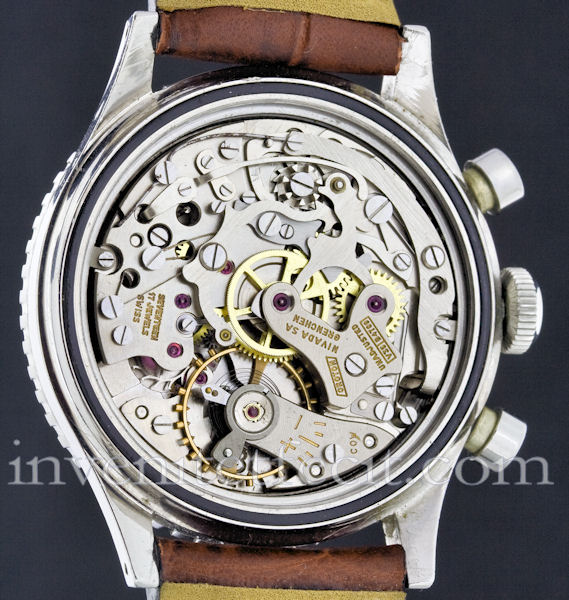
Calibre Valjoux 92 equipping the chronograph of illustration 3. Movement with column-wheel and swinging pinion.
Nivada did not make its ébauches and thus used Ebauches SA calibres. The most usual movement in the first versions of Chronomaster is the Valjoux 92, created in 1950. It's a good 13 lines movement, with a column-wheel. The system of chronograph is known as with rocker or swinging pinion: the wheel on field and the intermediate gear are replaced by a pinion which can slightly oscillate on its axis under the action of a rocker ordered starting from the column-wheel, and thus to gear with the wheel of center which carries the hand of the seconds of the chronograph. This makes it possible to make the saving in certain wheels, economy reinforced on this movement by the use of simple wire for certain springs. This system, of old design since Edouard Heuer had patented it in Germany in 1887, had been used for the first time at Ebauches SA on the Venus 170 of 1937 and Valjoux 77 a few years later.
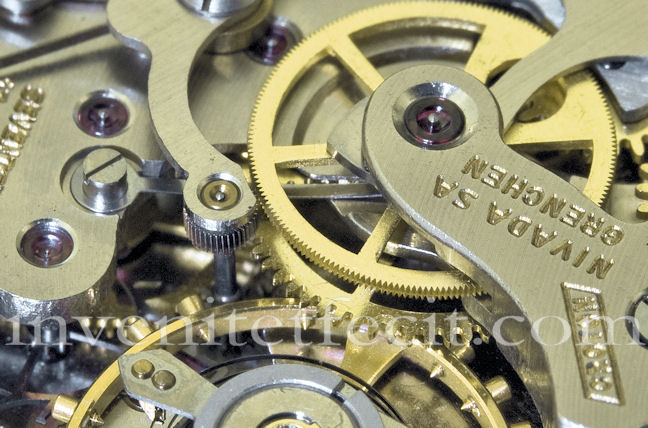
Detail of the pinion oscillating of the calibre Valjoux 92
One can also find in the first Chronomaster a more prestigious movement: the Valjoux 23, major movement in the history of the Swiss chronograph, that one finds at many brands, from Heuer to Rolex. It is a traditional movement, very well built, with column-wheel and without wire springs.
One can also find movements without column-wheel such as Landeron 210 and 248 and Venus 210.
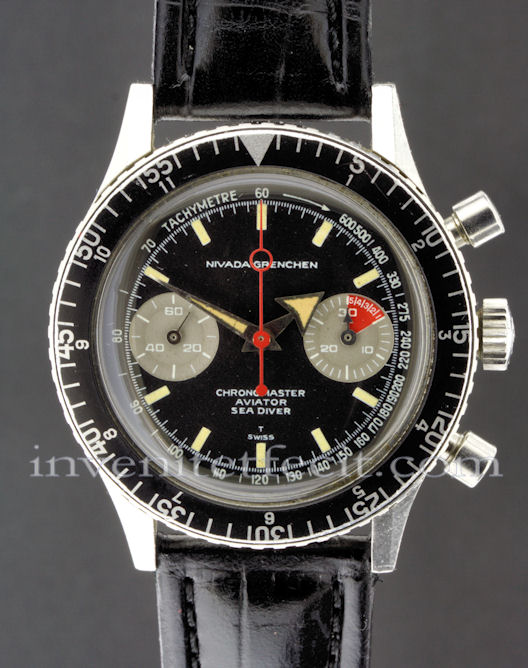
Version with gray sub-dials.

Calibre Valjoux 23 of the chronograph of illustration 6.

Detail of the wheel with column of the calibre Valjoux 23
Late models: 1970-1978
The Chronomaster had a considerable success and its production was prolonged until the end of the years 1970.
Its design was gradually modified. The dauphine and arrow hands were replaced by stick hands, with tritium, and the logo Nivada, a N in a blazon, appears sometimes on the dial.

Late model of Chronomaster signed Croton.

Calibre Valjoux 7733
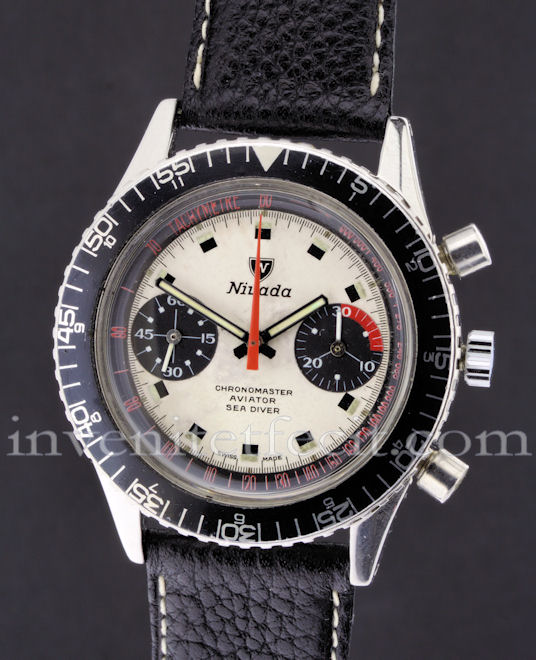
White version of a Chronomaster, calibre Valjoux 23
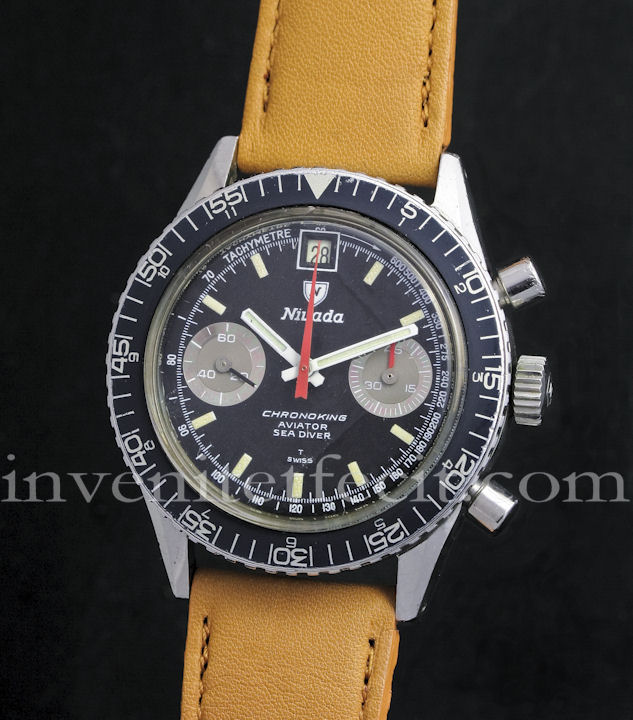
The superb Chronoking version with date
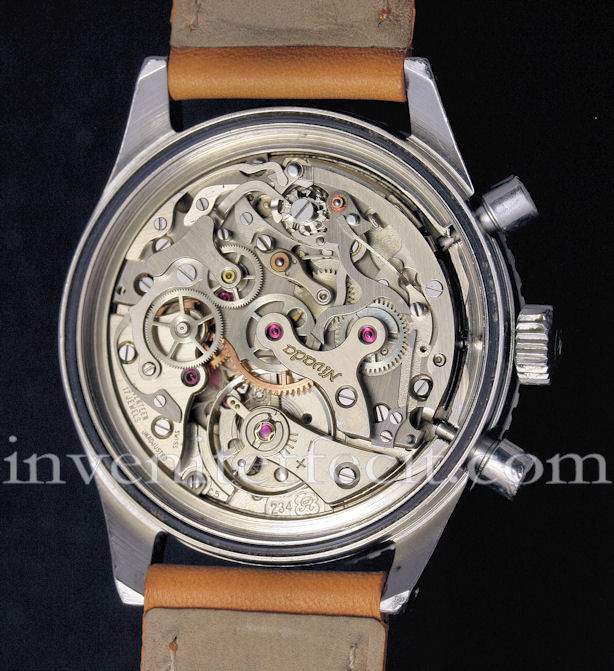
Calibre Valjoux 234
The Valjoux 92 disappears with the profit from Valjoux 7733 without column-wheel. The Valjoux 23 is always used and it will equip a beautiful version with a white dial and black meters as well as the model “Chronoking Aviator Sea Diver” with gray sub-dials which exists in a superb version with date at 12 and a 45 mn meter, provided with the beautiful calibre Valjoux 234.
What seems to be the ultimate version goes back to 1977: baptized “Chronograph Aviator Sea Diver” it comprises the date at 3 and is equipped with the calibre Valjoux 7765, non automatic version of the Valjoux 7755.
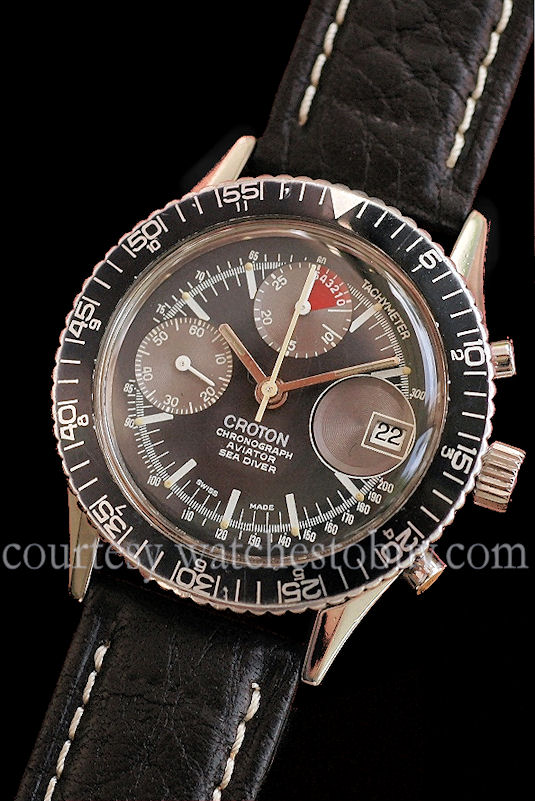
Probably the ultimate version of the Chronomaster.
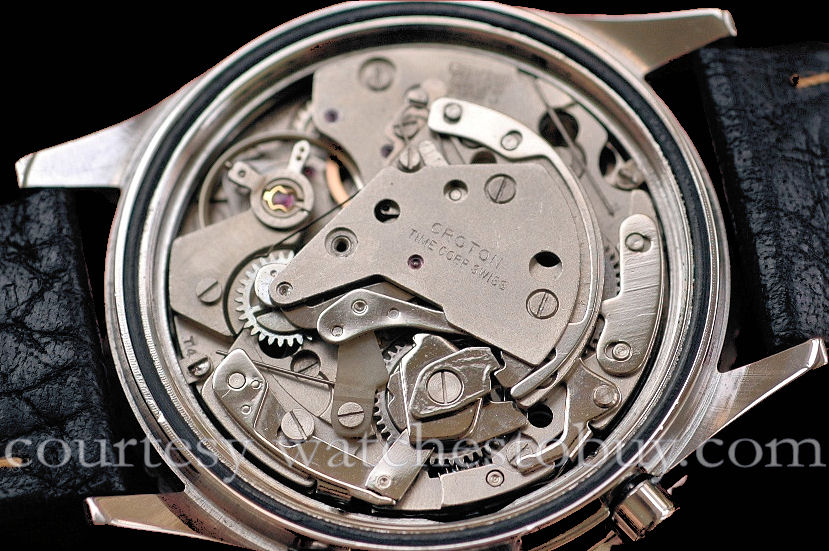
Calibre Valjoux 7765, manual wind version of the 7755
Nivada will try to face the crisis of the years 1970 with watches with avant-garde design, in particular the range Leonardo Da Vinci, then quartz watches, but it will not resist and will join the long list of the companies that have disappeared at the beginning of the year 1980.
Today the mark is still there but watches are made in China. Sad fate for a brand which has proposed one of the more attaching swiss chronographs of the 60's...
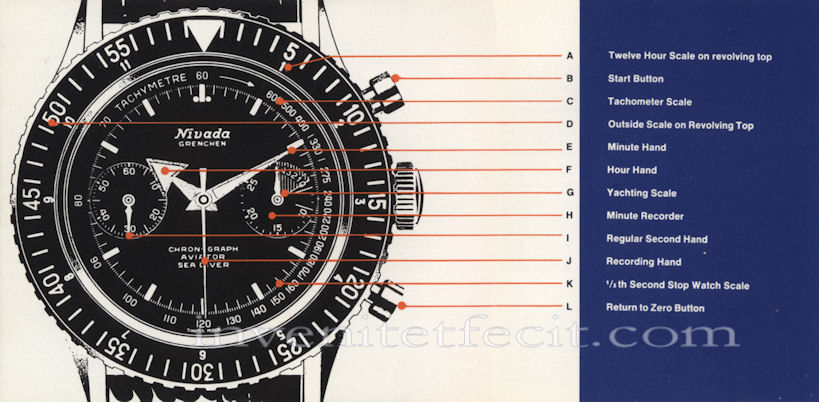
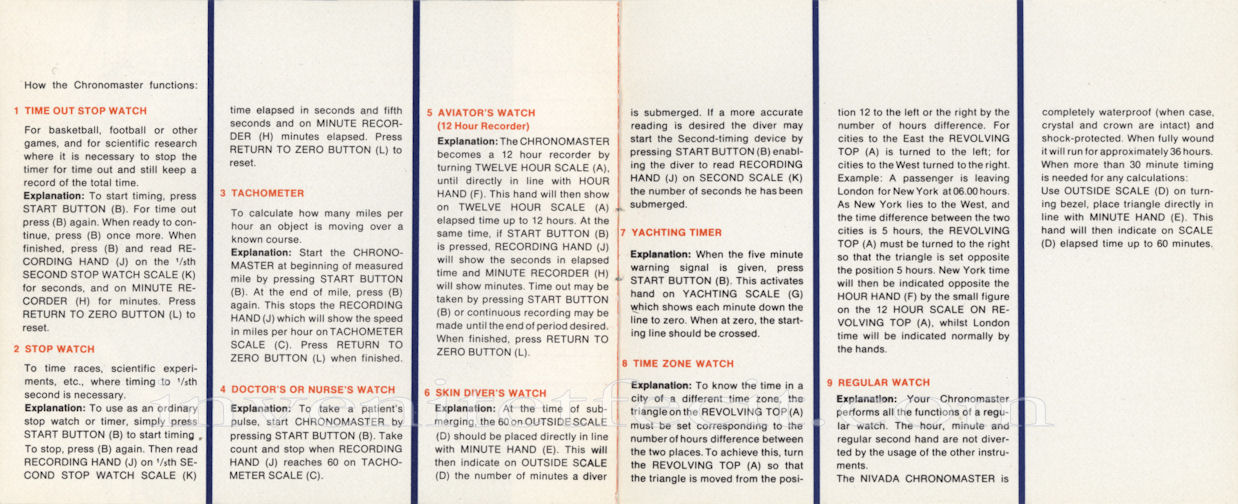
Notice provided with the Chronomaster chronograph about 1967
Thanks : this article profited from the councils of Sebastien Chaulmontet in Switzerland, Richard Askham in Holland and Derek Dier in Canada (www.WatchesToBuy.com). For the illustrations, thanks to Derek Dier, Gerd-R. Lang and Christian Pfeiffer-Belli. The majority of the documents were consulted at the Musée International d'Horlogerie at La Chaux-de-Fonds thanks to the kindness and the availability of all the team of Jean-Michel Piguet and Ludwig Oeschlin.
|